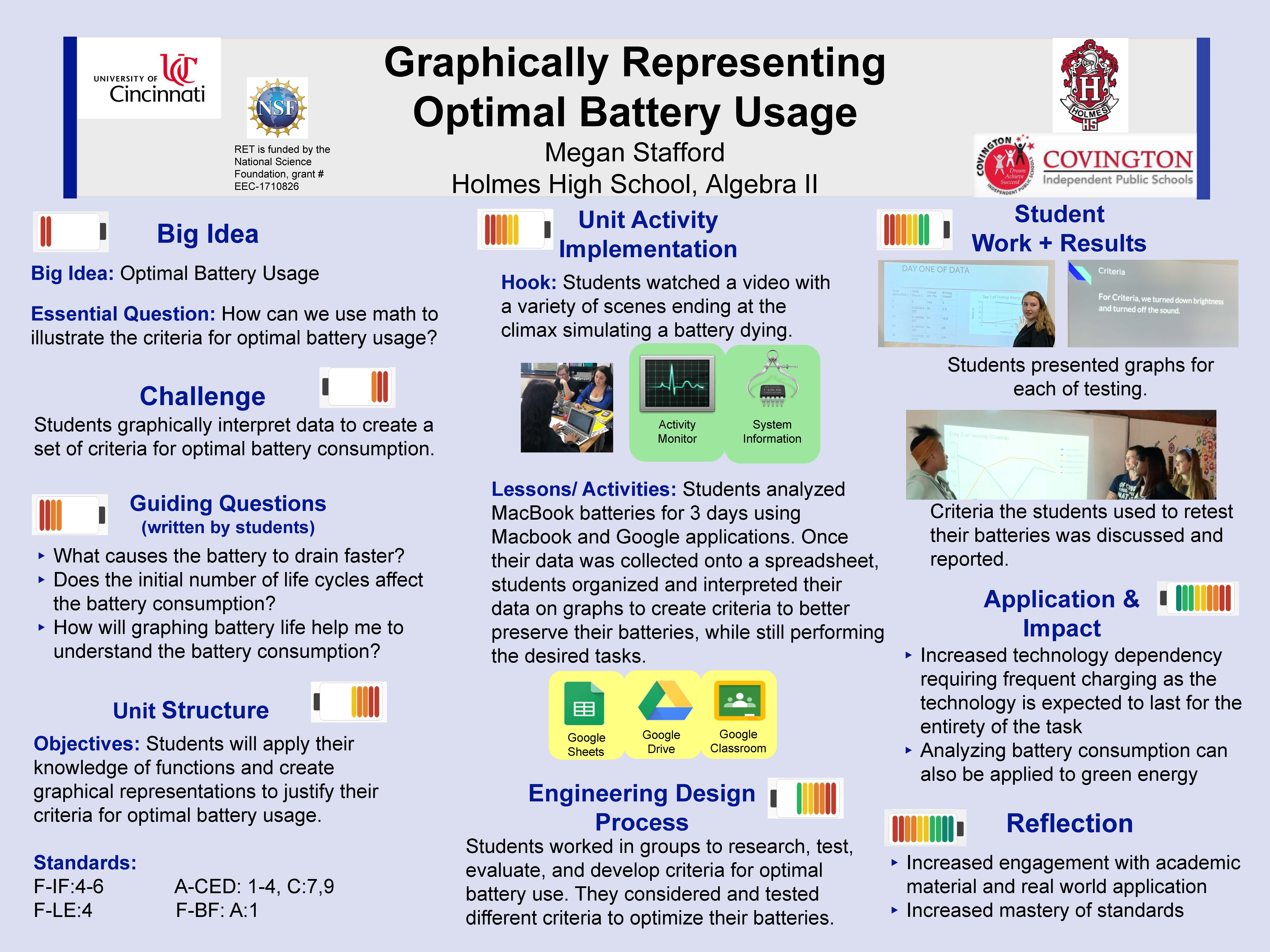Research Experience for Teachers (2018-2019)
Graphically Representing Optimal Battery Usage
 |
||||||
|
||||||
|
Pre/Post Test: Will conduct pre-test |
||||||
Keywords:
|
|
The Big Idea (including global relevance) Optimal Battery Usage: Better understanding the criteria for a battery can assist with improving current batteries especially for renewable energy. A large obstacle with renewable energy stems from the capacity of the batteries. |
|
Essential Questions
|
|
The Hook
|
|
The Challenge Students will use their MacBooks to analyze battery consumption and graphically interpret the data in order to create a set of criteria for ideal battery consumption. The 3-day consumption of the MacBook batteries will be analyzed using utilities on the MacBooks. |
|
Guiding Questions
|
ACS (Real world applications; career connections; societal impact)
The students can apply this unit to the real world as the majority carry cell phones and are constantly charging their phones throughout the school day, combatting the dead battery. Students can also apply this to the real world as every student has a MacBook that is expected to be fully charged at the beginning of the school day and last all day if utilized properly.
With much of our society dependent upon batteries and how they perform students can see how creating criteria for ideal battery consumption goes beyond playing movies or Fortnite all day on their MacBooks. Instead this criteria they create can be applied to ensure batteries are consumed in the most ideal way to allow for that piece of technology to be used for a longer period of time and used to its maximum capacity. This can be related to renewable energy source.
Introduce Engineering careers and have students introduce and discuss 2 examples of careers during their presentations when they Communicate Solutions.
Misconceptions
- A common misconception might be the necessary, school-related energy usage of their MacBooks versus wasted usage. The wasted usage is being directly represented during the activities as students observe their MacBooks batteries while watching movies, Netflix, playing games, etc.
Unit Lessons and Activities
- Lesson 1: Creating Equations in one variable and rearranging equations to highlight a desired variable. Students will be given an understanding of how their MacBooks are used and the ideal cycle life of their MacBook batteries. Students will practice rearranging equations while using the information supplied in the MacBook applications, such as amperage or voltage. (2 days)
- Activity 1: Introduction of Big Idea, Hook, Generating Essential Questions, Challenge, Pre-test, and Guiding Questions. (2 days)
- Activity 2: Gathering of information about the MacBooks’ batteries. This activity will specifically involve utilizing the applications on the MacBooks: System Information, Activity Monitor, Battery Health 1 & 2, and Coconut Battery. (1 day)
- Lesson 2: Interpreting and creating equations using tables and graphs. This will be taught using the data students have gathered from first round of testing. This knowledge will be reapplied after the second round of testing and then comparisons will be made to assist the students in refining their optimal battery usage criteria.
- Activity 3: Testing round 1 of MacBook usage. During this round of testing students will be working in their assigned groups and will begin monitoring and recording the data about their MacBooks’ batteries while constantly playing the determined usage. The above described applications will be used to obtain data. (3 days)
- Activity 4: Testing round 2 of MacBook usage. During this round of testing students have designated criteria to assist with optimal battery usage (reducing brightness, reducing sound, decreasing window size, etc.) and will test their MacBook batteries with the same usage but applying these criteria. The same applications will be used as described above. Once students have obtained this data they will interpret their data and refine their optimal battery usage criteria. (3 days)
- Evidence of CBL: Lesson, 1, Activity 1 & Lesson 2, Activity 4
- Evidence of EDP: Lesson 2, Activity 4
Additional Resources
